Toolbar/Command Bar
A glossary of the items available on the toolbar and the command bar of Motive.
Toolbar
The Toolbar contains commonly used functions and shortcuts to open Motive's various panes.

 Open File
Open File
Open Motive files: Calibration (MCAL) or (CAL), Takes (TAK), or Profile (MOTIVE) for asset definitions.
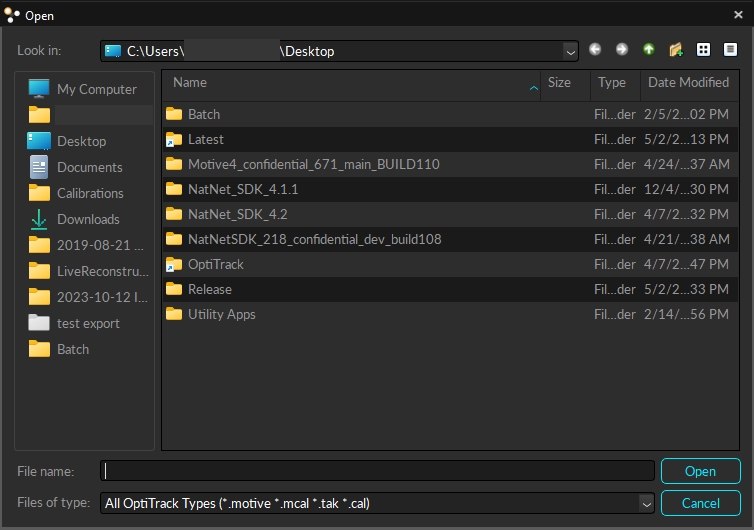
 Save All Takes
Save All Takes
Save all of the Takes that are loaded in the Data pane.
 Application Settings
Application Settings
Opens the Application Setting pane for software preferences. Reconstruction settings are also modified in this pane.
 Devices Pane
Devices Pane
Opens the Devices pane. This pane displays:
Tracking Cameras
Color Cameras
Synchronization devices (BaseStations, eSync2, OptiHub2)
Active Devices
 Calibration
Calibration
Opens the Calibration pane.
 Data Pane
Data Pane
Opens the Data pane for managing takes.
 Assets Pane
Assets Pane
Opens the Assets pane for managing the list of tracked assets as well as integrated devices such as force plates and data acquisition devices.
 Properties Pane
Properties Pane
Opens the Properties pane for managing the properties of selected items in Motive.
 Builder Pane
Builder Pane
Opens the Builder pane for defining or modifying Rigid Body, Skeleton, or Trained Markerset assets in Motive.
 Constraints Pane
Constraints Pane
Opens the Constraints pane for creating and configuring constraints associated each assets.
 Edit Tools Pane
Edit Tools Pane
Opens Edit Tools for post-processing pipelines.
 Graph View Pane
Graph View Pane
Opens the Graph View pane for monitoring the channel data.
 Log Pane
Log Pane
Opens the Log pane for monitoring activity.
 Viewport
Viewport
Opens additional Viewports.
 Probe Pane
Probe Pane
Opens the Probe pane for collecting sample points using the Probe.
 Info Pane
Info Pane
Opens the Info pane for monitoring real-time tracking data of a selected Rigid Body in Motive.
Command Bar
The Command bar contains menus of related commands. This section covers the items available on each menu.

File
The File tab contains commands related to opening, importing, exporting, and saving Motive files.
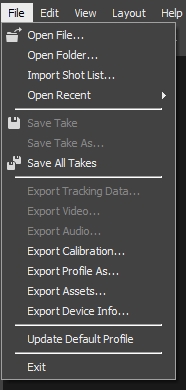
Open File...
Prompts the user to select a file to open. Applicable files include Take files (.tak), Camera Calibration files (.mcal or .cal), Motive user profile (.motive), and XML files.
Open Folder...
Imports a session folder into Motive. All of the TAK files within the session folder will be loaded in the Data pane.
Import Shot List...
Import a list of Take names to record from a CSV or XML file that contains Take names on each row. This allows users to plan which motions to capture ahead of the time (Please see the Data Recording page for more detail).
Save All Takes
Save all Takes from all of the sessions loaded in the Data pane.
Export Tracking Data...
Exports tracking data from a selected Take into the desired output format. See: Data Export.
Export Video...
Exports reference video to an AVI file. To play this file in Windows Media Player, a codec needs to be installed.
Export Audio...
Exports audio to into a WAV file. See: Audio Recording in Motive.
Export Profile As...
Exports the current software configurations into an application profile (MOTIVE).
Profile (MOTIVE) files: the MOTIVE profile stores software configurations. Software setting such as applications settings, streaming settings, trackable assets, synchronization configurations, and/or device configurations are saved into this file. The profile file can be exported and imported into Motive.
Export Assets...
Export just the assets (Rigid Bodies, Skeletons, Trained Markersets) to a MOTIVE file.
Export Device Info...
Exports the devices currently connected to Motive into a CSV file (i.e., Cameras and their serial numbers).
Update Default Profile
Manually update the current software configurations onto the default system profile. The default profile loads when launching Motive and is located at: C:\ProgramData\OptiTrack\MotiveProfile.motive.
Edit
The Edit tab contains commands related to editing tasks and changing application settings.
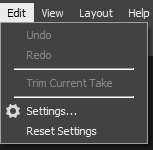
Trim Current Take
Archives the original take file and crops to the working range selected in the Graph View pane. For more information, read the Trimming Captured Takes page.
View
The View tab contains commands to open individual panes in the Motive interface. These commands are also available on the Motive toolbar.

Devices
Opens the Devices pane for controlling cameras and other devices in the system.
Calibration
Opens the Calibration for calibrating the camera system.
Data
Opens the Data pane for managing the recorded captures.
Assets
Opens the Assets pane for managing the list of tracked assets as well as integrated devices such as force plates and data acquisition devices.
Properties
Opens the Properties pane for managing the properties of selected items in Motive.
Info
Opens the Info pane for monitoring real-time tracking data of a Rigid Body.
Builder
Opens the Builder pane for creating trackable models or assets. Specifically, this pane is used for creating Rigid Body models, Skeleton models, and Trained Markersets in Motive.
Constraints
Opens the Constraints pane for managing selected Marker Sets assets.
Edit Tools
Opens the Edit Tools pane. For post-processing recorded marker data.
Labels
Opens the Labels pane. For monitoring, assigning, and/or modifying marker labels.
Graph 1 & Graph 2
Opens Graph View pane for monitoring the channel data.
Viewer
Opens an additional Viewport for additional viewports for monitoring 3D tracking and camera views.
Data Streaming pane
Opens the Data Streaming pane.
Log
Opens the Log pane for status messages.
Probe
Opens the Probe pane for using the Measurement Probe.
Layout
The layout tab allows you to select preset layouts that contain panes applicable to a specific task. This tab also contains commands that allow you to create and manage your own custom layouts.
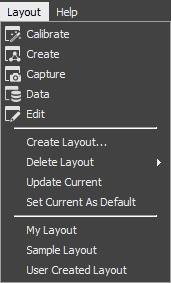
Calibrate
Displays panes applicable to system calibration. (Cameras, Perspective View, Camera Preview, Camera Calibration, Reconstruction)
Create
Displays panes applicable to asset creation and modification. (Project, Perspective View, Timeline, Skeleton, Rigid Bodies)
Create Layout
Saves the current layout. Saved custom layouts can be accessed from the drop-down menu located at the top-right corner of Motive or from the Layout menu.
Update Current
Updates the selected custom layout from the drop-down menu located at the top-right corner of Motive.
Custom Layouts
List of custom layouts that are created by the user. In the screenshot above, "My Layout," "Sample Layout," and "User Created "Layout" are examples of user-defined layouts.
Help
The Help tab contains useful links and licensing information.
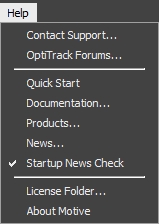
Quick Start
Opens the "About Motive" screen, which contains a link to the Quick Start Guide and our user documentation.
Was this helpful?

